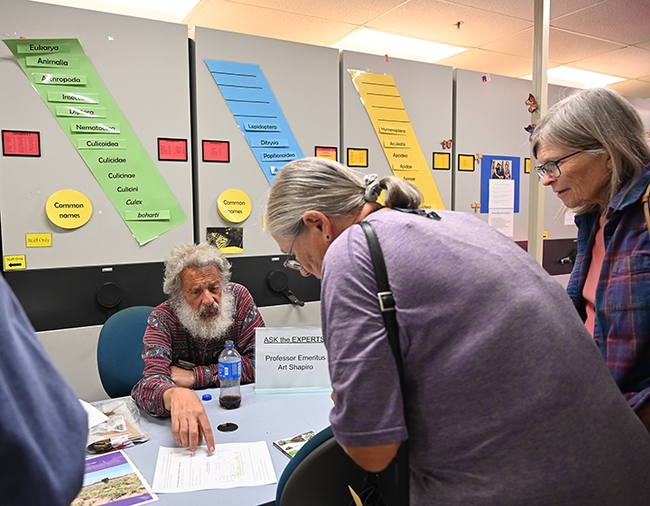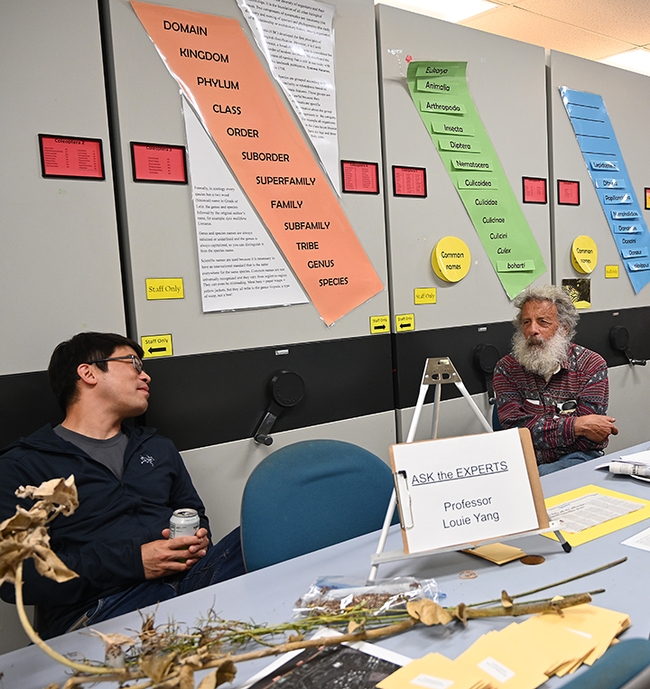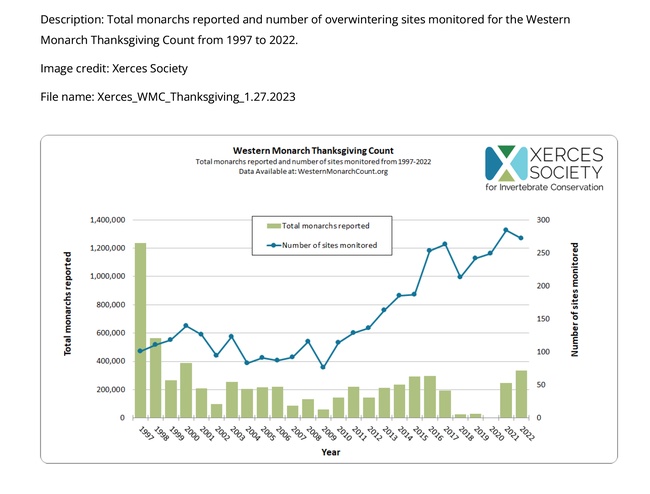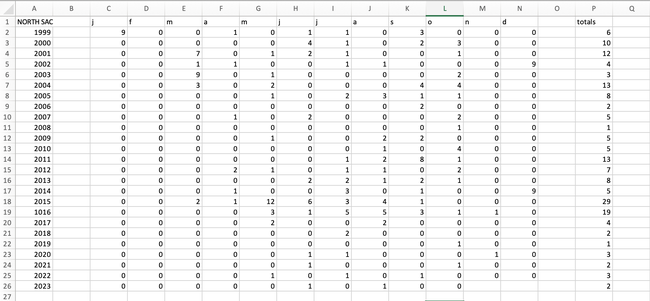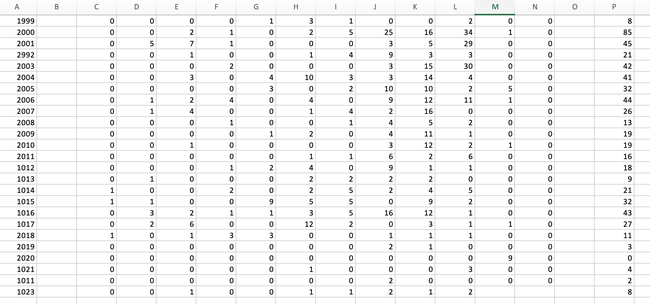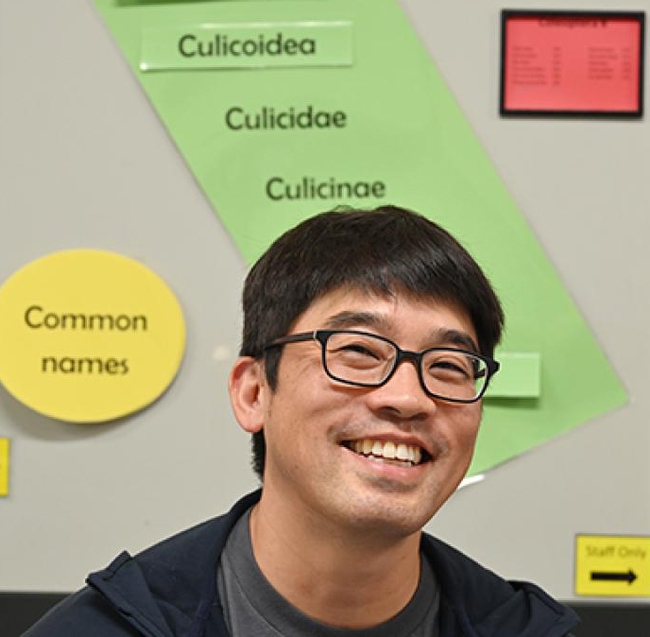- Author: Kathy Keatley Garvey
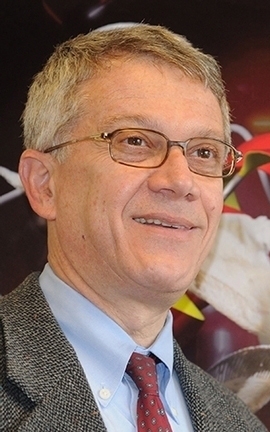
As mentioned earlier, two members of the Academic Senate's winners' circle are UC Davis Distinguished Professor Walter Leal of the Department of Molecular and Cellular Biology (and former professor and chair of the UC Davis Department of Entomology), and Professor Louie Yang of the Department of Entomology and Nematology (ENT).
Leal won the Distinguished Faculty Research Award (see Feb. 22 Bug Squad blog) and Yang won a Distinguished Teaching Award, undergraduate category (see Feb. 26 Bug Squad blog). UC Davis Distinguished Professor Bruce Hammock of ENT nominated Leal, while Joanna Chiu, professor and chair of ENT, nominated Yang.
The awards reception is Monday, May 13; more information is pending. "In all, 15 faculty members have received awards from the two groups at UC Davis," UC Davis Dateline reports. (See list of the recipients.)
Leal is the first UC Davis faculty member to win all three of the Academic Senate's most coveted awards: in research, teaching, and public service. In 2020, the Academic Senate awarded him the Distinguished Teaching Award for Undergraduate Teaching, and in 2022 Distinguished Scholarly Public Service Award.
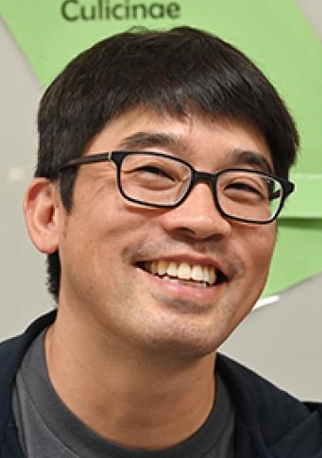
“Dr. Leal is an internationally recognized entomologist and a world leader in his field for his groundbreaking and transformative research in insect olfaction and chemical ecology,” Hammock wrote. "Walter is truly a renaissance man. "He chaired our entomology department from 2006 to 2008, and under his tenure, our department was ranked No. 1 in the country. I've long admired (1) his rigorous fundamental research programs supported by National Science Foundation, National Institutes of Health, and the U.S. Department of Food and Agriculture, and other agencies, (2) how he tackles and solves multiple challenging problems in insect olfaction and chemical ecology, (3) his grasp of how to organize and moderate highly successful worldwide research webinars (4) his generosity in helping other succeed and (4) his finely honed sense of humor."
Wrote Chiu: "I have watched him (Professor Yang) engage, inspire, and challenge his students, fostering creative and critical thinking like no one else I've ever seen. We deeply appreciate and admire his innovative and inclusive teaching, his exemplary work ethic, his welcoming demeanor, his dedication to his students, and his nationally recognized ecology expertise. Louie has received many well-deserved teaching and mentoring awards for his teaching contributions on and off campus.”
Of special note, too, is the James H. Meyer Distinguished Achievement Award, given annually to a member of the Academic Federation for "a distinguished record in research, teaching, and/or public service." This year the award went to Kirsten Gilardi, director of Karen C. Drayer Wildlife Health Center, and a health sciences clinical professor of Medicine and Epidemiology, School of Veterinary Medicine.
Wrote Dateline: "Health Sciences Clinical Professor Kirsten Gilardi has been part of the UC Davis Community since 1989. She is currently the director of the Karen C. Drayer Wildlife Health Center, a research, service and teaching center of excellence. In 2005, she founded the California Lost Fishing Gear Recovery Program, which hires experienced commercial scuba divers to remove gear and other marine debris from near-shore waters in a safe and environmentally sensitive manner. This program continues to help reduce the potential impact of losing fishing gear and marine debris on living marine resources and underwater habitat. Beyond her significant accomplishments in her field, her colleagues around the world highlight her passion for her position at UC Davis 'that expects her to protect wild animals and wild places.'"
Check out the Dateline website which includes a 2013 image of Gilardi with a silverback gorilla (image courtesy of Sandy Buckey.)
They all do UC Davis proud!
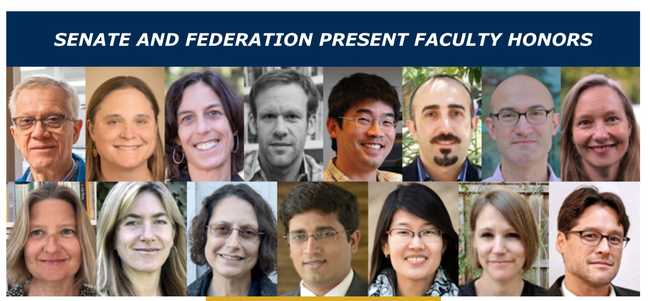
- Author: Kathy Keatley Garvey
Professor Louie Yang's monarch and milkweed research at the University of California, Davis, is quite celebrated.
Yang, a community ecologist and professor in the Department of Entomology and Nematology, is involved in monarch conservation science and planning, in collaboration with the Western Monarch Conservation Science Group, U.S. Fish and Wildlife Service, the Xerces Society of Invertebrate Conservation, Monarch Joint Venture, Environment Defense Fund, and the National Monarch Summit in D.C.
- Science Friday, National Public Radio, interviewed him in February 2022 about his monarch-milkweed research. (Listen to the archived interview.)
- He was one of 12 invited scientists nationwide who delivered a presentation during the two-day Monarch Butterfly Summit, held in June 2022 at the Capitol, Washington D.C. He has presented invited seminars at Purdue University and the University of Nevada.
Another feat: Yang launched the Monitoring Milkweed-Monarch Interactions for Learning and Conservation (MMMILC) project in 2013 for students in the environmental science program at Davis Senior High School or those associated with the Center for Land-Based Learning's Green Corps program. He taught more than 150 high school-aged participants. Their tasks: monitoring milkweed-monarch interactions in a project funded by the National Science Foundation. He organized and led a 135-member team, and supported them all as co-authors of the paper, “Different Factors Limit Early- and Late-Season Windows of Opportunity for Monarch Development,” published in July 2022 in the journal Ecology and Evolution. The 107 co-authors included high school students, undergraduate and graduate students, and community members.
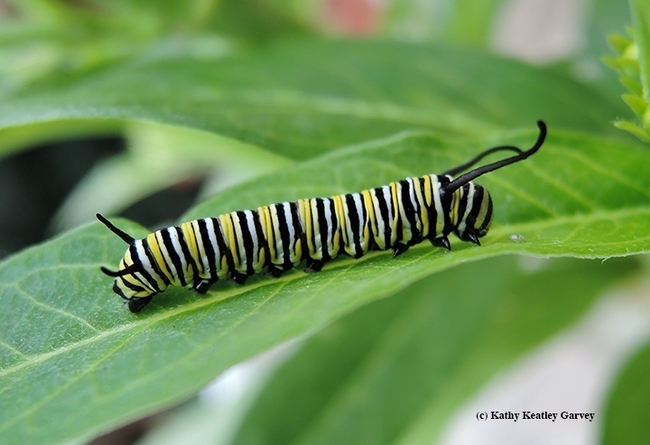
But did you know that Professor Yang excels at teaching and mentoring?
Described as “a phenomenal teacher, mentor and an incredibly strong advocate for students,” Yang is the newly announced recipient of the UC Davis Academic Senate's 2024 Distinguished Teaching Award, Undergraduate Student category.
And so well-deserved.
“I have watched him engage, inspire, and challenge his students, fostering creative and critical thinking like no one else I've ever seen,” Joanna Chiu, professor and chair of the department, wrote in her nomination letter. “We deeply appreciate and admire his innovative and inclusive teaching, his exemplary work ethic, his welcoming demeanor, his dedication to his students, and his nationally recognized ecology expertise. Louie has received many well-deserved teaching and mentoring awards for his teaching contributions on and off campus.”
Professor Yang is one of the three co-founders and co-directors (along with Professor Chiu and UC Davis distinguished professor Jay Rosenheim) of the campuswide, one-of-a-kind Research Scholars Program in Insect Biology (RSPIB), launched in 2011 to help students learn cutting-edge research through close mentoring relationships with faculty.
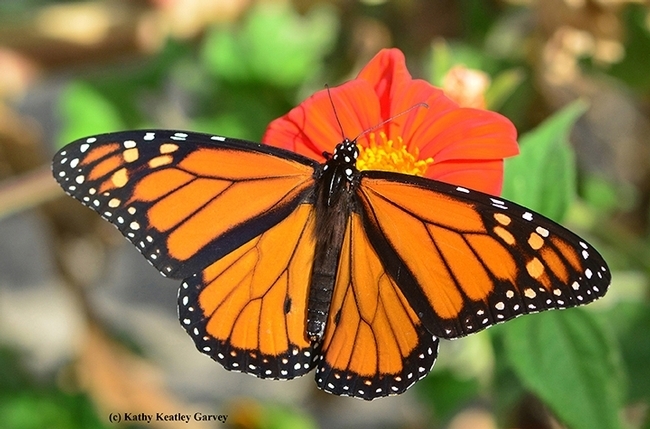
Yang, who holds a bachelor's degree in ecology and evolution (1999) from Cornell University, and a doctorate in population biology (2006) from UC Davis, joined the UC Davis faculty in 2009. UC Davis distinguished professor Walter Leal, then chair of the entomology department, remembers recruiting and hiring him, on the recommendation of community ecologist Richard "Rick" Karban.
In 2012, as an assistant professor, Yang was selected a Hellman Fellow and then received a 2013-2018 National Science Foundation Faculty Early Career Award. In 2015, he won a Chancellor's Teaching Fellow Award and the Atwood Colloquium Rising Star Award in Ecology, University of Toronto. Currently he chairs the Entomology Graduate Program and also serves as interim vice chair while community ecologist and associate professor Rachel Vannette is on sabbatical.
Since 2009, Yang has taught more than 600 undergraduates and more than 90 graduate students in his formal classes. His courses include Insect Ecology, Community Ecology, Experimental Ecology and Evolution in the Field, He has taught two National Science Foundation Graduate Research Fellowship Program (GRFP) grant writing workshops, and the Population Biology Graduate Group core course for three years.
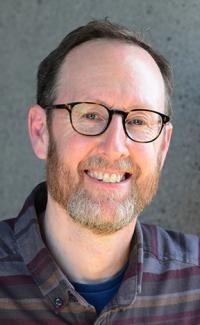
Professor Rosenheim, recipient of the 2011 Academic Senate Distinguished Teaching Award, Undergraduate Level, has observed Yang's innovative teaching. “His class sessions were impeccably organized, his presentations deeply insightful, and the discussions highly engaging," he wrote. "Louie alternated lectures with class sessions in which large blocks of time were devoted to structured debates. For the debates, Louie drew names at random and assembled two 3-person teams of students, one arguing the 'pro' side of the issue, the other arguing the 'con' side. After an initial period when positions were presented and rebuttals given, the whole class was invited to join in the discussion. What was truly remarkable was the high level of participation that Louie is able to elicit, both during the debates and during his lectures. Louie inspires the confidence of his students, and they reciprocate with their willingness to take risks during class by contributing, even when discussing topics that are new to them. This is not an easy thing to accomplish; Louie's ability to gain such strong student participation is perhaps the strongest evidence of Louie's talent in connecting with students. I was so impressed with the success of Louie's methods that I decided to incorporate structured debates into one of my own classes as well."
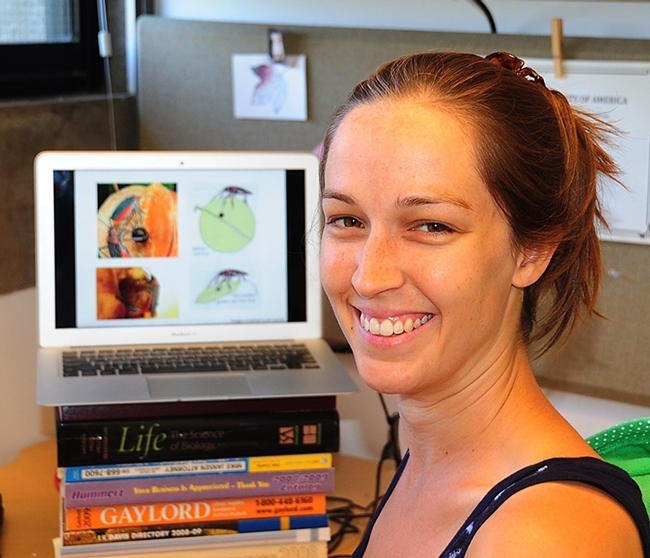
In unsolicited comments in Rate My Professors, his students wrote:
- “One of the best instructors at UC Davis. Class on insects was very interesting…He is super cool, and lectures are never boring.”
- “Louie honestly might be my favorite professor on campus. He is cool and smart and engaged with his students…”
- “Really one of the most intelligent people I've met in college. It's apparent just talking to him, which I'd highly recommend.”
- “I loved this seminar, Ecology Outdoors! I learned so much from Louie, and he's really good at encouraging creativity and experimentation. He's a very hard worker and plans the class well.”
- “Really cool guy, made the class interesting. gave a lot of real-life example, so students can relate the subject to real world.”
A tip of the insect net to Professor Louie Yang!
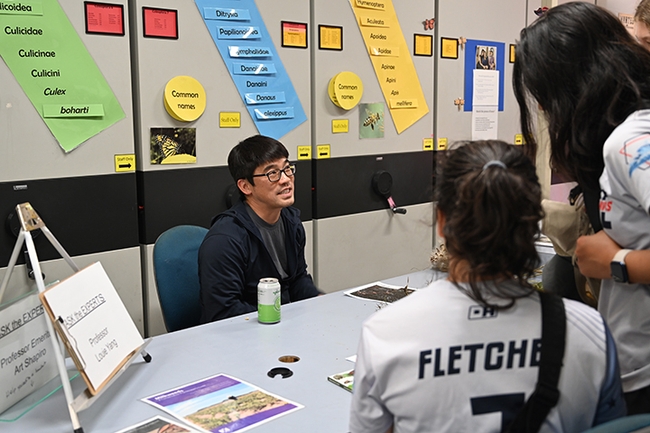
- Author: Kathy Keatley Garvey
It's New Year's Day and it's common for folks to turn over a new leaf.
What about the old leaves?
Sometimes if you turn over an old leaf this time of year in Solano and Yolo counties, you might find a monarch caterpillar. As of today, we have two monarchs munching away in our pollinator garden in Vacaville. They've survived through freezing temperatures, heavy winds and steady rain.
Back in the late summer and early fall, monarchs fluttered into our gardem to lay their eggs. We provide four species of milkweed. Every fall we cut back the milkweed, but not until all the 'cats are gone. This year the 'cats "weren't gone."
Monarchs surprise us. Some of our December/January sightings:
- A monarch in flight on Dec. 16, 2023 in west Vacaville
- A monarch in flight on Jan. 3, 2023 near Vacaville High School
- A monarch caterpillar munching Jan. 23, 2021 in our garden.
We remember UC Davis distinguished professor Art Shapiro (now emeritus) of the Department of Evolution and Ecology telling us that he recorded a monarch in flight on Jan. 19, 2020 in Sacramento, but even earlier than that--UC Davis professor Louie Yang of the Department of Entomology and Nematology spotted one flying Jan. 8, 2012 in east Davis.
Shapiro, who has monitored the butterfly populations of Central California since 1972, maintains esearch website at http://butterfly.ucdavis.edu/. His 10 sites stretch from the Sacramento River Delta through the Sacramento Valley and Sierra Nevada mountains to the high desert of the Western Great Basin. It's the largest and oldest database in North America, and was recently cited by British conservation biologist Chris Thomas in a worldwide study of insect biomass.
The monarch Shapiro saw on Jan. 29, 2020, however, wasn't in his research project. As he told it in an email to his posse: "We had a visitor today--a British journalist--who wanted to go on a site walk. Rancho Cordova was next up. We went in his rental car. We were on US 50, just passing the Tower Theater in Sacramento heading eastbound, when, at 10.30 a.m. (temperature in mid-upper 50s, light North wind, mostly sunny), a Monarch, sex unknown, flew across the freeway in front of us, 20-22' up, from SW to NE. There is no possibility of error, unless I am having visual hallucinations."
And the monarch caterpillar we saw in our garden on Jan. 23, 2021? "Evidence of inland winter breeding," Shapiro told us. "Nothing surprises me any more..."
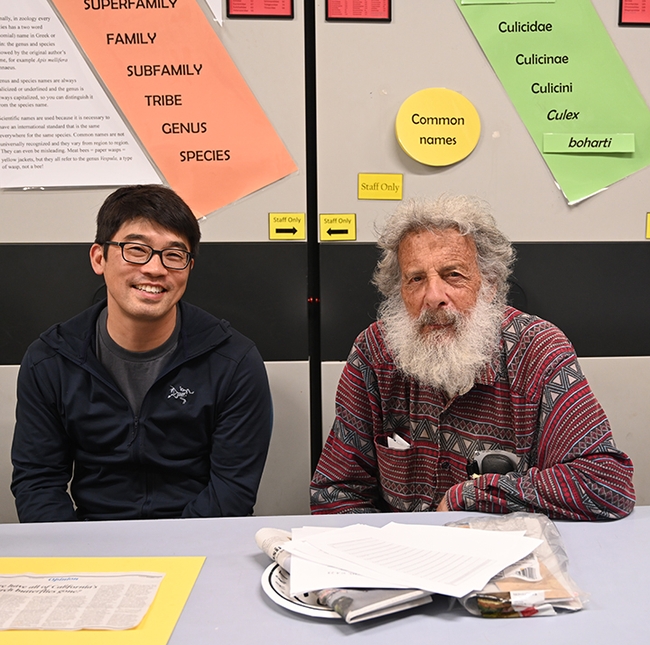
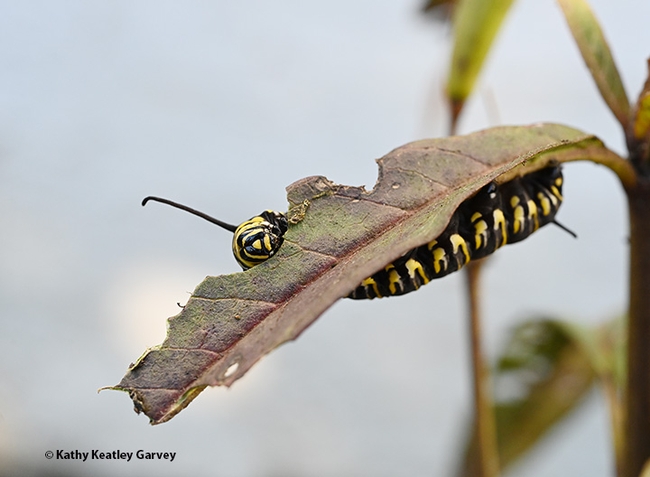

- Author: Kathy Keatley Garvey
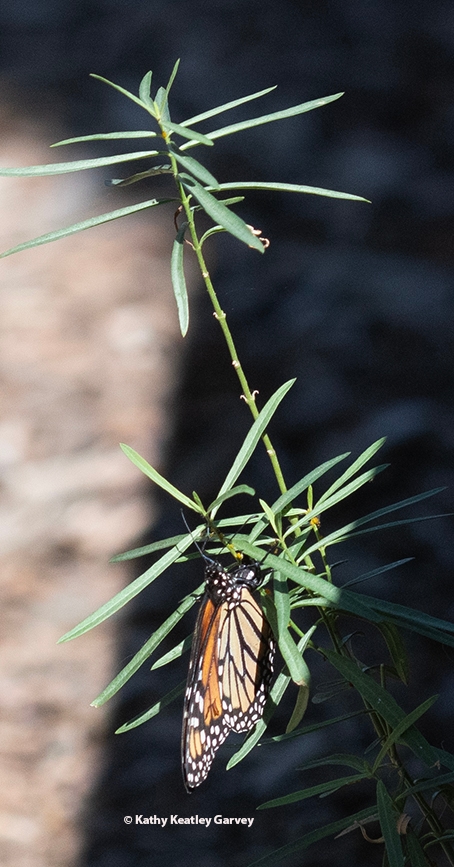
Where do Western monarchs go after leaving their overwintering sites along coastal California in February?
An observation: They didn't stop in the spring or summer to deposit eggs on any of our four species of milkweed in our Vacaville pollinator garden.
Spring? Zero. Zilch. Nada.
Summer? Zero. Zilch. Nada.
Fall? Yes.
Why not spring and summer? Did the monarchs passing through Vacaville opt for "a better habitat" in the cooler Pacific Northwest and beyond (British Columbia)?
"I wish I knew," commented UC Davis distinguished professor emeritus Art Shapiro, who has monitored the butterfly populations of Central California since 1972 and maintains a research website, Art's Butterfly World.
Beginning in September, as many five monarchs a day began fluttering into our garden. Some laid eggs.
To date, we've spotted some 20 eggs and caterpillars.
"This is generally consistent with the pattern we've seen in previous years," said UC Davis Department of Entomology and Nematology professor Louie Yang, who researches monarchs. "Even in Davis, we've been seeing more caterpillars in the late summer/fall. I think this is probably because some are stopping to lay eggs on the return migration, and the fall population is much larger than the spring migration population. Looking very carefully, we did also see eggs in the spring each year, but very few of them developed into large caterpillars." See the Louie Yang et al, research paper, "Different Factors Limit Early- and Late-Season Windows of Opportunity for Monarch Development," published in July 2022 in the journal, Evolution and Ecology.
The availability of food resources, such as tropical milkweed (Asclepias curassavica) that can overwinter in warmer climates, doesn't deter them from migrating, said UC Davis emeritus professor Hugh Dingle of the Department of Entomology and Nematology. Dingle, an internationally known expert on animal migration who has studied monarchs for more than two decades, said: "Migration and the diapause that accompanies it in the fall are determined by shortening photoperiod and temperature (warm temps can override short days hence the issue with climate change)."
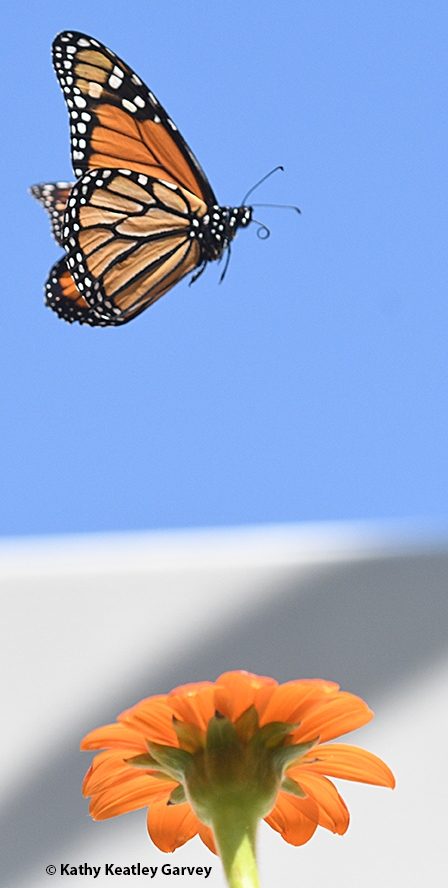
Said UC Davis professor Elizabeth Crone of the Department of Evolution and Ecology: "Monarchs may behave similarly in spring, but the spring population is probably much smaller than the fall one, so they are less likely to happen across your garden. Our estimate is that the population increases 2-3x each generation (so it's about 100-200x larger in Fall than Spring), then resets each year due to mortality during Fall migration and overwintering. There is some research from Sonia Altizer's lab in Georgia showing that monarch butterflies that encounter milkweeds during fall migration will leave reproductive diapause and breed. It is unknown whether these monarchs are effectively lost from the migratory population, or whether they or their offspring (the caterpillars in your yard) will continue on to the overwintering sites."
"The egg-laying females you are seeing now are likely migrants that have eschewed reproductive dormancy for reproduction," says entomologist David James, an associate professor at Washington State University who researches migratory monarchs. "This has probably always happened to some extent but is likely more significant now because of warmer falls."
"The lack of activity in summer in Vacaville was probably a function of most of the population having dispersed further east and north, maybe more than usual? They surely did pass through Vacaville in spring on their way north but clearly didn't stop to use your milkweeds. It does seem that some years they are more prone to frequent stopping/oviposition on their way north and east, yet in others they just keep flying. There's evidence that the latter was the case this year... with as many migrants making it to BC as to Washington... Normally they stop in Washington and only a handful make it to BC."
"The many mysteries of monarchs," James added.
James is the author of a newly published book, The Lives of Butterflies: A Natural History of Our Planet's Butterfly Life (Princeton University) with colleague David Lohman of the City College of New York. The book, released in the UK on Oct. 3, 2023, will be available in the United States starting Jan. 9, 2024.
Irish scientist Éanna Ní Lamhna recently interviewed the WSU entomologist in a podcast on RTÉ, or Raidió Teilifís Éireann. The book, she said, "showcases extraordinary diversity of world's butterflies, while exploring their life histories, behavior, conservation and other aspects of these most fascinating and beguiling insects." (See Bug Squad blog)
Listen to the butterfly podcast here: https://www.rte.ie/radio/radio1/clips/22294525/
Meanwhile, are you seeing fall breeding and egg-laying in your garden? We have for more than a decade, with some monarchs eclosing in November and December.

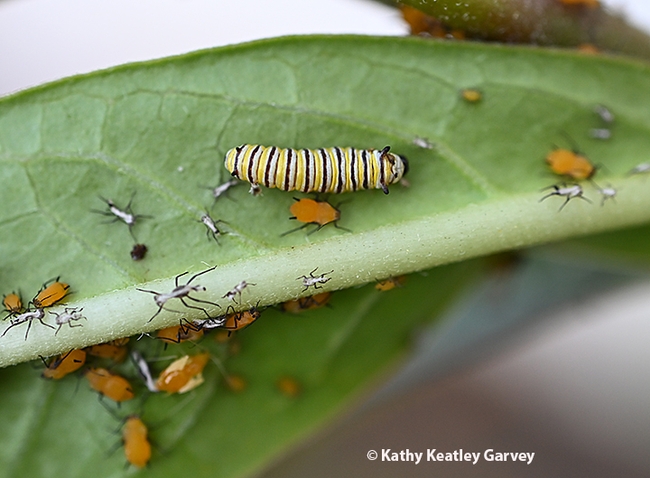
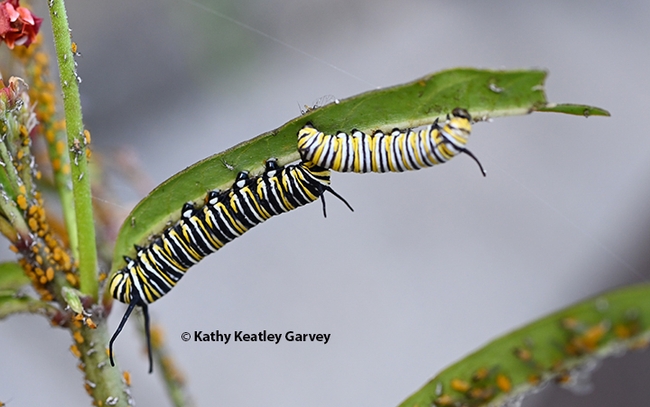
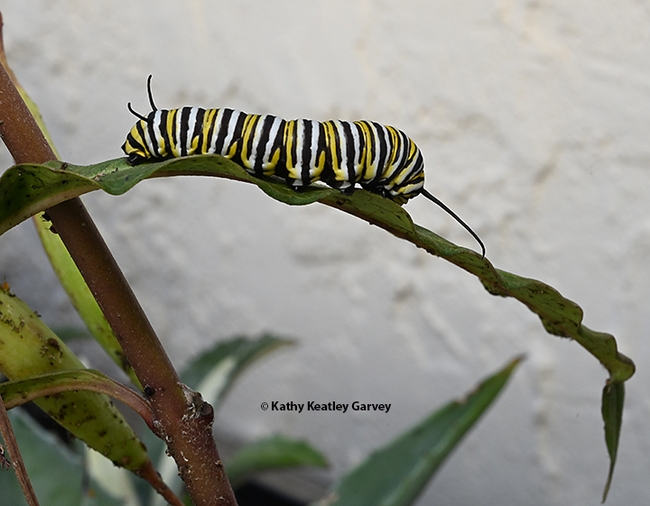

- Author: Kathy Keatley Garvey
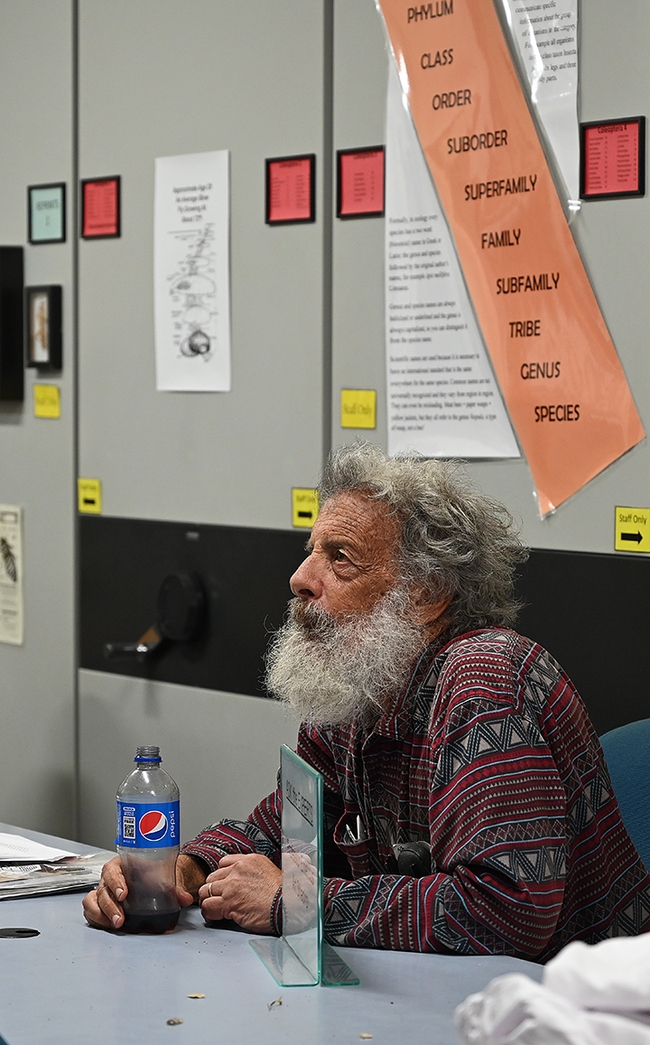
He points out that he is a Lepidopterist but "not a monarch specialist."
Shapiro's 10 monitoring sites stretch from the Sacramento River Delta through the Sacramento Valley and Sierra Nevada mountains to the high desert of the Western Great Basin. The largest and oldest database in North America, it was recently cited by British conservation biologist Chris Thomas in a worldwide study of insect biomass.
Shapiro records his research on his website at http://butterfly.ucdavis.edu/.
At the Bohart Museum open house, his topics included the research that he co-authored, "Understanding a Migratory Species in a Changing World: Climatic Effects and Demographic Declines in the Western Monarch Revealed by Four Decades of Intensive Monitoring" (Anne Espeset et al), published in Oecologica in 2017. Professor Matthew Forister of the University of Nevada, one of his former graduate students, is among the co-authors.
The abstract: "Migratory animals pose unique challenges for conservation biologists, and we have much to learn about how migratory species respond to drivers of global change. Research has cast doubt on the stability of the eastern monarch butterfly (Danaus plexippus) population in North America, but the western monarchs have not been as intensively examined. Using a Bayesian hierarchical model, sightings of western monarchs over approximately 40 years were investigated using summer flight records from ten sites along an elevational transect in Northern California. Multiple weather variables were examined, including local and regional temperature and precipitation. Population trends from the ten focal sites and a subset of western overwintering sites were compared to summer and overwintering data from the eastern migration. Records showed western overwintering grounds and western breeding grounds had negative trends over time, with declines concentrated early in the breeding season, which were potentially more severe than in the eastern population. Temporal variation in the western monarch also appears to be largely independent of (uncorrelated with) the dynamics in the east. For our focal sites, warmer temperatures had positive effects during winter and spring, and precipitation had a positive effect during spring. These climatic associations add to our understanding of biotic-abiotic interactions in a migratory butterfly, but shifting climatic conditions do not explain the overall, long-term, negative population trajectory observed in our data."

Handout. "When I was asked to participate in this event, it got me thinking…" Shapiro began in his monarch comments handout.
"My group did an analysis of the Monarch vis-à-vis climate in a 2017 paper (Espeset et al.,, DOI: 10.1007/s00442-01607600-1) None of my group is a Monarch specialist, and that includes me. Since 1999 I have done counts of all butterfly species at 4 Valley sites (Suisun, West Sacramento, North Sacramento and Rancho Cordova) using standard “Pollard walk” methods, slightly modified. As a result we have a quantitative picture of Monarchs in breeding season... Such data are very rare. Population estimates of Monarchs are typically based on the overwintering (non-breeding) aggregations and we know from published material that what breeding-season data exist routinely diverge from the overwintering data. That is, trends in population size as measured by overwinter animals are not routinely reflected in the summer numbers. There can be a variety of explanations for this. To me the most likely is that as a very mobile species, the Monarch may breed in different places in different years, so that a monitoring program like mine, based on a limited number of fixed, Intensively-monitored sites, is unlikely to capture this stochasticity in where Monarchs breed. I am attaching the overwintering estimates from the Xerces Society. Direct quantitative comparisons are inappropriate, but you can judge how well the local trends match them just by eyeball (until we develop a convincing statistical approach to the problem!)
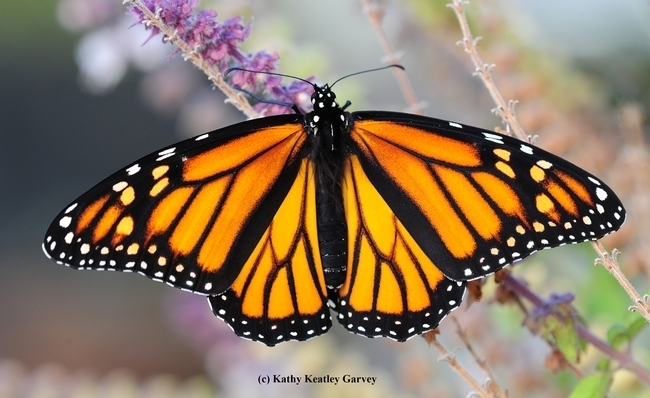
"My assignment for today forced me back to the original data for my Valley sites. The actual data are reproduced on the attached sheets. It is immediately evident that:
- There is very high variability in Monarch numbers among years at all sites, but
- There are short-term trends that may be associated with climatic fluctuations, in particular drought, and
- Among my sites, Suisun has had the highest counts, partly but not entirely reflecting coastward migration from farther inland early in the season, but these high numbers have effectively disappeared—perhaps reflecting a systematic change in migratory trajectories, and
- Rancho Cordova has very consistently had the lowest counts, with little year-to-year variation compared to other sites..
"My interest is now piqued and I am going to go with this. From 1972 to 1998 at all sites, and from 1972 to date at our 5 mountain sites, monitoring was on a presence/absence basis only because there are too many species to Pollard-count simultaneously. But the seasonal distribution of the Monarch is still easily extracted. We know Monarch breeding seasonality has changed over the 50-year time span of this study. We also have devised and published methods to use presence-absence data (“day-positives”) as a crude proxy for population trends. This is perhaps a good moment to revisit the Espeset et al. paper and try to get into the specific components of Monarch trends. Suggestions are welcome!" (amshapiro@ucdavis.edu)
Shapiro, who joined the UC Davis faculty in 1971, continues his research. The author of the book, Field Guide to Butterflies of the San Francisco Bay Area and Sacramento Valley Regions, he has studied more than 160 species of butterflies in his transect.
